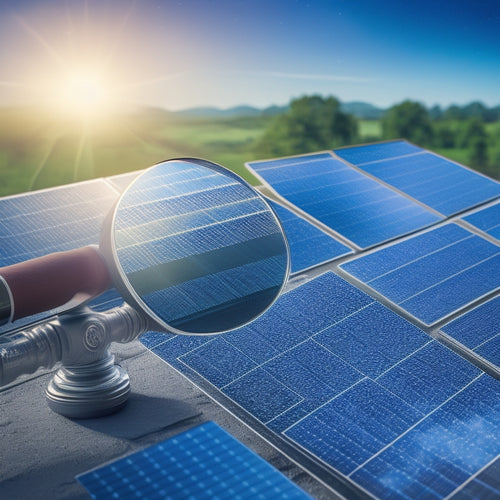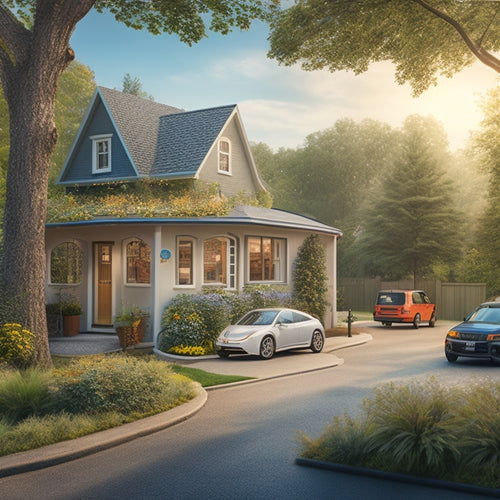
What Affects the Average Cost of a Home Solar Power System
Share
When determining the average cost of a home solar power system, you'll need to take into account several key factors. The size and efficiency of the system, as well as the installation company and labor costs, play a significant role. Your roof's size and complexity, including obstructions and orientation, also impact the final cost. Additionally, battery backup and storage options, local incentives and rebates, federal rebate amounts, and permitting and inspection fees all contribute to the overall expense. Moreover, the quality of equipment and materials used can affect performance and durability. Understanding these factors is essential to making an informed decision - and there's more to investigate.
Key Takeaways
- The size and efficiency of the solar system, including the type of panels and installation quality, significantly impact the overall cost.
- Installation company and labor costs, which can account for 10-15% of the total cost, vary based on complexity and local market conditions.
- Roof size and complexity, including obstructions and angles, influence the installation process and cost, with more complex roofs requiring more labor and materials.
- Battery backup and storage options, including capacity and type, add to the system cost, with lithium-ion batteries offering high efficiency at a higher price point.
- Local incentives, rebates, and federal tax credits, such as the Solar Investment Tax Credit, can reduce the average cost of a home solar power system.
System Size and Efficiency
The size and efficiency of a home solar power system greatly impact its overall cost and effectiveness. You'll want to take into account these factors when determining the ideal system for your home.
The size of your system, measured in watts (W), directly affects the cost, with larger systems requiring more panels and infrastructure. However, a larger system also means more energy yield, which can lead to greater savings on your electricity bill.
The type of solar panels you choose also plays a significant role in efficiency. Monocrystalline silicon panels, for example, are more efficient than polycrystalline panels, but they're also more expensive. You'll need to weigh the benefits of higher efficiency against the added cost.
Additionally, the efficiency of your system can be affected by factors like panel orientation, shading, and temperature. By optimizing these factors, you can maximize your energy yield and get the most out of your investment.
Installation Company and Labor
Your solar power system's installation company and labor costs play a crucial role in the overall expense of going solar. The installer's experience and knowledge greatly impact the quality of the installation, which in turn affects the system's performance and longevity. A seasoned installer will guarantee a more efficient and safe installation, reducing the likelihood of costly rework or repairs down the line.
Labor costs vary depending on the installation company's overhead, the complexity of the installation, and the local labor market conditions. On average, labor costs account for around 10% to 15% of the total system cost. However, this percentage can be higher or lower depending on the specific circumstances of your installation.
When selecting an installation company, it's crucial to research and compare quotes from different providers. Look for installers with extensive experience, excellent customer reviews, and certifications from reputable organizations like the North American Board of Certified Energy Practitioners (NABCEP).
Roof Size and Complexity
When you're considering a home solar power system, you'll need to factor in the size and complexity of your roof.
Roof obstructions, such as skylights, vents, and chimneys, will affect the installation process and cost.
Additionally, if your roof has multiple levels or angles, it may require more labor and materials, increasing the overall expense.
Roof Obstructions Matter
Intricate rooflines and obstructions greatly impact the average cost of a home solar power system. As you contemplate installing solar panels, you'll need to evaluate your roof's intricacy and how it affects the installation process. Obstructions such as skylights, vents, and chimneys can increase the installation time and cost.
| Obstruction | Impact on Installation |
|---|---|
| Skylights | Requires additional labor and materials to work around |
| Vents | May need to be relocated or sealed to guarantee watertight integrity |
| Chimneys | May require specialized equipment to maneuver |
| Roof valleys | Can create shading issues, affecting energy consumption |
| Multiple roof angles | Increases installation intricacy and time |
When evaluating your roof, you'll need to contemplate factors such as shading analysis, roof orientation, and structural integrity. These factors will impact the installation timing, maintenance costs, and overall energy consumption of your solar power system. Additionally, aesthetic considerations and local regulations may also influence the installation process. By understanding the intricacies of your roof, you can better plan and budget for your home solar power system.
Number of Levels
A larger roof size and increased complexity come with a higher number of levels, greatly driving up the average cost of a home solar power system.
As you reflect on installing solar panels on your multi-level home, you'll need to account for the additional labor and materials required to traverse the complex roof layout. This added complexity can increase the installation time, leading to higher labor costs.
Additionally, a larger roof size means more solar panels are needed to meet your energy consumption requirements, further driving up costs.
When evaluating the cost of a home solar power system, it's crucial to take into account the number of levels on your roof. A single-level home with a simple roof layout will generally have a lower installation cost compared to a multi-level home with multiple roof angles and obstructions.
Be prepared to invest more in your solar power system if you have a larger, more complex roof. However, the long-term benefits of reduced energy consumption and lower utility bills can make the investment worthwhile.
Battery Backup and Storage
Two key factors to contemplate when evaluating a home solar power system are its ability to provide backup power during grid outages and its capacity for energy storage.
When you consider battery backup and storage, you're looking for energy independence and a reliable source of power when the grid goes down.
Here are three essential considerations:
-
Battery Capacity: A larger battery capacity means more energy storage, but it also increases the system's cost. You'll need to balance your energy needs with your budget.
-
Battery Types: Different battery types, such as lead-acid, lithium-ion, or saltwater batteries, have varying characteristics. Lithium-ion batteries, for instance, offer high charging efficiency but are more expensive.
-
Maintenance Costs: Battery maintenance costs can add up over the system's lifespan. Look for batteries with low maintenance requirements to minimize expenses.
As you weigh these factors, keep in mind the environmental impact and technology advancements.
A well-designed battery backup and storage system can provide you with a reliable source of energy while reducing your reliance on the grid.
Local Incentives and Rebates
You'll want to investigate local incentives and rebates to maximize your savings on a home solar power system.
State tax credits can provide a significant reduction in your taxable income, while utility company incentives may offer additional discounts or rebates.
Additionally, you'll want to factor in the federal rebate amount, which can further reduce your upfront costs.
State Tax Credits
Beyond federal incentives, state tax credits and local rebates can greatly reduce the cost of a home solar power system. As a homeowner, you can benefit from these financial incentives, which vary by state and locality.
-
State policies: Some states offer tax credits that can be claimed in addition to federal credits, further reducing your tax liability.
-
Solar awareness: States with high solar awareness often offer more generous incentives, driving up market demand and reducing costs.
-
Economic conditions: Economic conditions, such as high energy prices, can create a favorable environment for solar adoption, leading to more incentives and rebates.
To take advantage of these incentives, it's important to understand your state's tax regulations and policies.
Homeowner education is key to traversing the complex environment of financial incentives. By staying informed, you can make the most of available incentives, reducing the average cost of a home solar power system and achieving energy independence.
Utility Company Incentives
In addition to state and federal incentives, local utility companies often offer their own incentives and rebates to encourage the adoption of home solar power systems. These incentives can greatly reduce the upfront cost of your solar power system. For instance, some utility companies offer rebates based on the system's capacity or the amount of electricity it produces.
Additionally, they may provide special utility rate structures that benefit homeowners with solar power systems.
You should also look into the interconnection policies of your local utility company. These policies can affect the cost of installing and maintaining your solar power system. Some utility companies may charge fees for connecting your system to the grid, while others may offer net metering, which allows you to sell excess energy back to the grid and offset your utility bills.
When researching local incentives, be sure to check with your utility company directly, as these offers can vary widely depending on your location and the company's policies. By taking advantage of these incentives, you can further reduce the cost of your home solar power system.
Federal Rebate Amount
Your federal rebate amount, also known as the Solar Investment Tax Credit (ITC), is a significant incentive that can help offset the cost of your home solar power system. As a homeowner, you're eligible for a tax credit of 26% of the total cost of your solar panel system. This credit can be claimed on your federal income taxes, reducing your taxable income.
Here are three key things to know about the federal rebate amount:
-
The ITC is a non-refundable credit, meaning you can only claim it up to the amount of taxes you owe.
-
The credit applies to the total cost of your solar panel system, including equipment, installation, and other expenses.
-
The ITC is set to decrease over time, so it's important to take advantage of it now to maximize your savings.
Keep in mind that federal policies can change, so it's vital to stay informed about the latest solar incentives.
Permitting and Inspection Fees
Across the United States, local governments and utility companies require homeowners to obtain permits and undergo inspections before connecting a solar power system to the grid. These bureaucratic obstacles come with a price tag. You'll need to factor in the cost of permits and inspections when calculating the total cost of your solar power system.
The permitting process typically involves submitting plans and specifications for your system to local authorities, who review them to guarantee compliance with building codes and safety standards.
The inspection requirements will vary depending on your location, but you can expect to pay for at least one inspection to verify that your system is installed correctly and meets safety standards. These fees can range from a few hundred to several thousand dollars, depending on the complexity of your system and the jurisdiction you're in.
Be sure to factor these costs into your overall budget to avoid any unexpected surprises. On average, permitting and inspection fees can add up to 5-10% to the total cost of your solar power system.
Quality of Equipment and Materials
The quality of equipment and materials used in your solar power system directly impacts its performance, durability, and overall cost.
When investing in a home solar power system, you want to ascertain that the equipment and materials used are of high quality to maximize energy production and minimize maintenance costs.
Three key factors to evaluate when assessing the quality of equipment and materials are:
-
Equipment durability: Look for equipment with a proven track record of withstanding harsh weather conditions and lasting for 25 years or more.
-
Material sourcing: Verify that materials are sourced from reputable suppliers to guarantee high-quality components.
-
Certifications and warranties: Check for certifications from recognized organizations, such as UL (Underwriters Laboratories) and IEC (International Electrotechnical Commission), and extensive warranties that cover equipment and performance.
Frequently Asked Questions
How Long Does It Take to Install a Home Solar Power System?
You'll typically spend 1-3 days waiting for permits and 2-5 days on installation, but your unique installation timeline depends on factors like roof complexity, system size, and local regulations, so be prepared to adapt to your specific situation.
Can I Install a Solar Power System Myself to Save Money?
You can attempt a DIY installation to save money, but be prepared to maneuver through complex solar permits and potentially void your warranty; it's often recommended to leave the job to professionals to guarantee a safe and efficient system.
Are There Any Solar Power System Warranties or Guarantees?
You'll want to investigate warranty types, including equipment and workmanship guarantees, as well as performance guarantees that guarantee your system meets energy production expectations, providing you with peace of mind and protection for your investment.
Can I Sell Excess Energy Generated Back to the Grid?
You can sell excess energy back to the grid through net metering, which measures your system's output and provides credits on your utility bill; many utilities offer energy buyback policies, allowing you to offset your consumption and save money.
How Often Should I Clean My Solar Panels for Optimal Performance?
You should clean your solar panels every 6-12 months as part of regular solar panel maintenance to guarantee peak performance, but cleaning frequency may vary depending on your location's climate and environmental factors.
Conclusion
As you weigh the benefits of switching to solar power, you're likely wondering what's driving the cost of your new system. It's not just the panels themselves, but a complex mix of factors. You've seen how system size and efficiency, installation company and labor, roof size and complexity, battery backup and storage, local incentives and rebates, permitting and inspection fees, and quality of equipment and materials all play a role. Now, the question is: what's the final tally going to be?
Related Posts
-

Solar Panel System Certification Costs: A 10-Point Breakdown
You're looking to understand the costs associated with solar panel system certification. Your total certification cos...
-

Why Nearby EV Conversion Shops Matter to You
Having a nearby EV conversion shop means you'll experience the benefits of a more personalized, convenient, and susta...
-

What Makes a Road Bike-Friendly by Design?
As you plan and design roads, incorporating features like dedicated bike lanes, smooth surfaces, and traffic calming ...


